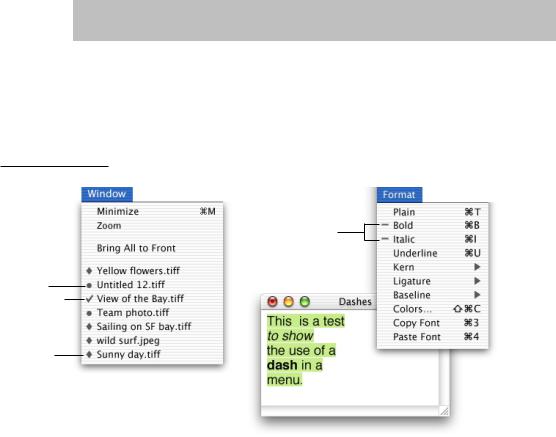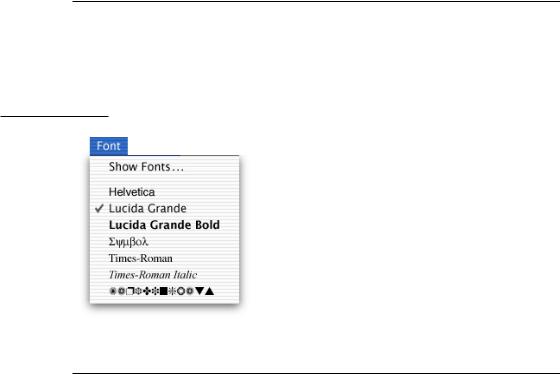
- •Contents
- •Figures and Tables
- •Introduction to the Aqua Human Interface Guidelines
- •The Benefits of Applying the Interface Guidelines
- •Deciding What to Do First
- •Tools and Resources for Applying the Guidelines
- •If You Have a Need Not Covered by the Guidelines
- •Human Interface Design
- •Human Interface Design Principles
- •Metaphors
- •See-and-Point
- •Direct Manipulation
- •User Control
- •Feedback and Communication
- •Consistency
- •WYSIWYG (What You See Is What You Get)
- •Forgiveness
- •Perceived Stability
- •Aesthetic Integrity
- •Modelessness
- •Knowledge of Your Audience
- •Worldwide Compatibility
- •Cultural Values
- •Language Differences
- •Default Alignment of Interface Elements
- •Resources
- •Universal Accessibility
- •Visual Disabilities
- •Hearing Disabilities
- •Physical Disabilities
- •The Dock
- •The Dock’s Onscreen Position
- •Dock Notification Behavior
- •Dock Menus
- •Clicking in the Dock
- •Menus
- •Menu Elements
- •Menu Titles
- •Menu Items
- •Grouping Items in Menus
- •Hierarchical Menus (Submenus)
- •Menu Behavior
- •Scrolling Menus
- •Toggled Menu Items
- •Sticky Menus
- •Standard Pull-Down Menus (The Menu Bar)
- •The Apple Menu
- •The Application Menu
- •The Application Menu Title
- •The Application Menu Contents
- •The File Menu
- •The Edit Menu
- •The View Menu
- •The Window Menu
- •The Help Menu
- •Menu Bar Status Items
- •Other Menus
- •Contextual Menus
- •Using Special Characters and Text Styles in Menus
- •Using Symbols in Menus
- •Using Text Styles and Fonts in Menus
- •Using Ellipses in Menus and Buttons
- •Windows
- •Window Layering
- •Window Appearance and Behavior
- •Textured Windows
- •Opening and Naming Windows
- •Positioning Windows
- •Closing Windows
- •Moving Windows
- •Resizing and Zooming Windows
- •Active and Inactive Windows
- •Click-Through
- •Scroll Bars and Scrolling Windows
- •Automatic Scrolling
- •Minimizing and Expanding Windows
- •Windows With Changeable Panes
- •Special Windows
- •Drawers
- •When to Use Drawers
- •Drawer Behavior
- •Utility Windows
- •The About Window
- •Dialogs
- •Types of Dialogs and When to Use Them
- •Document-Modal Dialogs (Sheets)
- •Sheet Behavior
- •When to Use Sheets
- •When Not to Use Sheets
- •Alerts
- •Dialog Behavior
- •Accepting Changes
- •The Open Dialog
- •Saving, Closing, and Quitting Behavior
- •Save Dialogs
- •Closing a Document With Unsaved Changes
- •Saving Documents During a Quit Operation
- •Saving a Document With the Same Name as an Existing Document
- •The Choose Dialog
- •The Printing Dialogs
- •Controls
- •Control Behavior and Appearance
- •Push Buttons
- •Push Button Specifications
- •Radio Buttons and Checkboxes
- •Radio Button and Checkbox Specifications
- •Selections Containing More Than One Checkbox State
- •Pop-Up Menus
- •Pop-Up Menu Specifications
- •Command Pop-Down Menus
- •Command Pop-Down Menu Specifications
- •Combination Boxes
- •Combo Box Specifications
- •The Text Entry Field
- •The Scrolling List
- •Placards
- •Bevel Buttons
- •Bevel Button Specifications
- •Toolbars
- •Pop-Up Icon Buttons and Pop-Up Bevel Buttons
- •Slider Controls
- •Slider Control Specifications
- •Tab Controls
- •Tab Control Specifications
- •Progress Indicators
- •Text Fields and Scrolling Lists
- •Tools for Creating Lists
- •Text Input Field Specifications
- •Scrolling List Specifications
- •Image Wells
- •Disclosure Triangles
- •Layout Guidelines
- •Group Boxes
- •Sample Dialog Layouts
- •Using Small Versions of Controls
- •User Input
- •The Mouse and Other Pointing Devices
- •Using the Mouse
- •Clicking
- •Double-Clicking
- •Pressing
- •Dragging
- •The Keyboard
- •The Functions of Specific Keys
- •Character Keys
- •Modifier Keys
- •Arrow Keys
- •Function Keys
- •Key Combinations Reserved by the System
- •Recommended Keyboard Equivalents
- •Creating Your Own Keyboard Equivalents
- •Keyboard Focus and Navigation
- •Full Keyboard Access Mode
- •Type-Ahead and Auto-Repeat
- •Selecting
- •Selection Methods
- •Selection by Clicking
- •Selection by Dragging
- •Changing a Selection With Shift-Click
- •Changing a Selection With Command-Click
- •Selections in Text
- •Selecting With the Mouse
- •What Constitutes a Word
- •Selecting Text With the Arrow Keys
- •Selections in Graphics
- •Selections in Arrays and Tables
- •Editing Text
- •Inserting Text
- •Deleting Text
- •Replacing a Selection
- •Intelligent Cut and Paste
- •Editing Text Fields
- •Entering Passwords
- •Fonts
- •Icons
- •Icon Genres and Families
- •Application Icons
- •User Application Icons
- •Viewer, Player, and Accessory Icons
- •Utility Icons
- •Non-Application Icons
- •Document Icons
- •Icons for Preferences and Plug-ins
- •Icons for Hardware and Removable Media
- •Toolbar Icons
- •Icon Perspectives and Materials
- •Conveying an Emotional Quality in Icons
- •Suggested Process for Creating Aqua Icons
- •Tips for Designing Aqua Icons
- •Drag and Drop
- •Drag and Drop Design Overview
- •Drag and Drop Semantics
- •Move Versus Copy
- •When to Check the Option Key State
- •Selection Feedback
- •Single-Gesture Selection and Dragging
- •Background Selections
- •Drag Feedback
- •Destination Feedback
- •Windows
- •Text
- •Multiple Dragged Items
- •Automatic Scrolling
- •Using the Trash as a Destination
- •Drop Feedback
- •Finder Icons
- •Graphics
- •Text
- •Transferring a Selection
- •Feedback for an Invalid Drop
- •Clippings
- •Language
- •Style
- •Terminology
- •Developer Terms and User Terms
- •Labels for Interface Elements
- •Capitalization of Interface Elements
- •Using Contractions in the Interface
- •Writing Good Alert Messages
- •User Help and Assistants
- •Apple’s Philosophy of Help
- •Help Viewer
- •Providing Access to Help
- •Help Tags
- •Help Tag Guidelines
- •Setup Assistants
- •Files
- •Installing Files
- •Where to Put Files
- •Handling Plug-ins
- •Naming Files and Showing Filename Extensions
- •Displaying Pathnames
- •Speech Recognition and Synthesis
- •Speech Recognition
- •Speakable Items
- •The Speech Recognition Interface
- •Speech-Recognition Errors
- •Guidelines for Implementing Speech Recognition
- •Speech Synthesis
- •Guidelines for Implementing Speech Synthesis
- •Spoken Dialogues and Delegation
- •General Considerations
- •Installation and File Location
- •Graphic Design
- •Menus
- •Pop-Up Menus
- •Windows
- •Utility Windows
- •Scrolling
- •Dialogs
- •Feedback and Alerts
- •The Mouse
- •Keyboard Equivalents
- •Text
- •Icons
- •User Documentation
- •Help Tags
- •Document Revision History
- •Glossary
- •Index

C H A P T E R 4
Menus
Using Special Characters and Text Styles in Menus
You can use several standard characters (described below) to indicate additional information in menus. Don’t use other, arbitrary symbols in menus because they add visual clutter and may confuse people.
Figure 4-12 Don’t use arbitrary symbols in menus
Using Symbols in Menus
In the Window menu, a checkmark should appear next to the active document’s name. Checkmarks can also be used in other menus to indicate that the setting applies to the entire selection. You can use checkmarks for mutually exclusive attribute groups (the user can select only one item in the group, such as font size) or accumulating attribute groups (more than one item can be selected at once, such as Bold and Italic).
Using Special Characters and Text Styles in Menus |
65 |
Apple Computer, Inc. June 2002

C H A P T E R 4
Menus
Use dashes to indicate that an attribute applies to only part of the selection. For example, if selected text has two styles applied to it, put a dash next to each style name. When it’s appropriate, you can combine checkmarks and dashes in the same menu.
Note: Include a menu command, such as Plain, for removing all formatting from mixed-state text.
Use a bullet next to a document with unsaved changes, and a diamond for a document the user has minimized into the Dock. A minimized document with unsaved changes should have a diamond only. If the active window has unsaved changes, the checkmark should override the bullet in the Window menu.
Figure 4-13 Symbols in menus
A bullet indicates
the document has unsaved changes.
A checkmark indicates the active window.
A diamond indicates the window has been minimized into the Dock.
Dashes are used to indicate that the selection represents a mixed state (both bold and italic are used).
For Cocoa applications, these symbols are managed by the Cocoa framework. In Carbon, if you use the standard Window menu, these symbols are managed automatically. Otherwise, use the SetItemMark function with a char parameter of kCheckCharCode for the active document, kBulletCharCode for a document with unsaved changes, and kDiamondCharCode for a minimized document.
66Using Special Characters and Text Styles in Menus
Apple Computer, Inc. June 2002

C H A P T E R 4
Menus
Using Text Styles and Fonts in Menus
In a Style or Font menu, you can display menu items in the actual style or font so users can see what effect the text attribute will have.
Don’t use text styles in menus other than a Style or Font menu.
Figure 4-14 A Font menu displayed with different fonts
Using Ellipses in Menus and Buttons
An ellipsis character (…) after a menu item or button label indicates to the user that additional information is required to complete a command. You should use an ellipsis in the following cases:
■An action that requires further user input to complete or presents an alert allowing the user to cancel the action. Examples include Find, Go To, Open, Page Setup, and Print.
■An action that opens a settings window. The main function of settings windows is to allow the user to change some aspect of the application, not the document content. Examples include Set Title, Preferences, and Options.
Using Special Characters and Text Styles in Menus |
67 |
Apple Computer, Inc. June 2002
C H A P T E R 4
Menus
Don’t use an ellipsis in the following cases:
■An action that requires no further user input to complete and does not present an alert. Often the item to be acted upon is already selected. Examples include New, Cut, Bold, and Quit.
■An action that opens an informational, accessory, or tool window. These windows can be implemented as either utility windows (as in the case of a color palette) or modeless windows. These windows provide tools that help create or manage the content in the main window and are frequently left open to assist in accomplishing the task of the main window. Examples include Get Info and Show Tools.
68Using Special Characters and Text Styles in Menus
Apple Computer, Inc. June 2002
